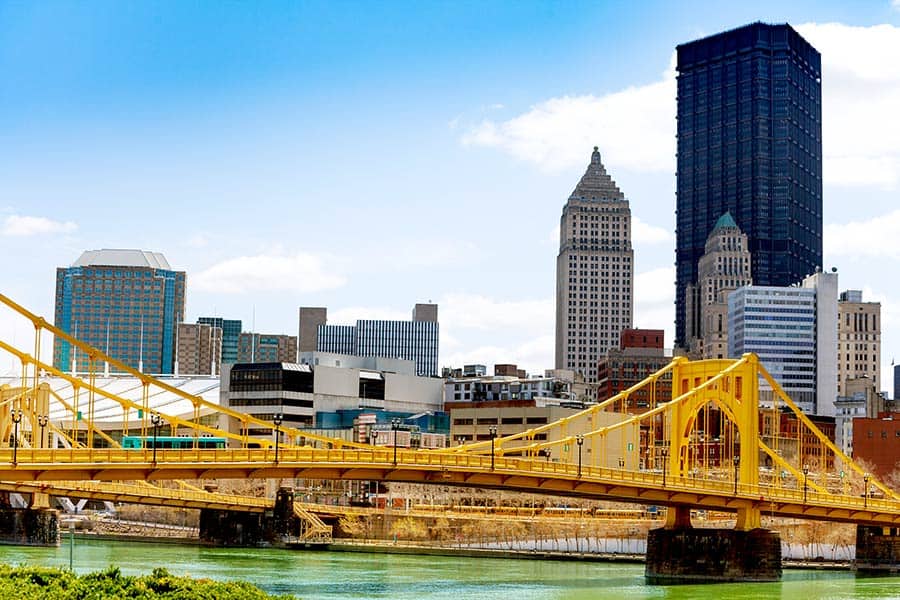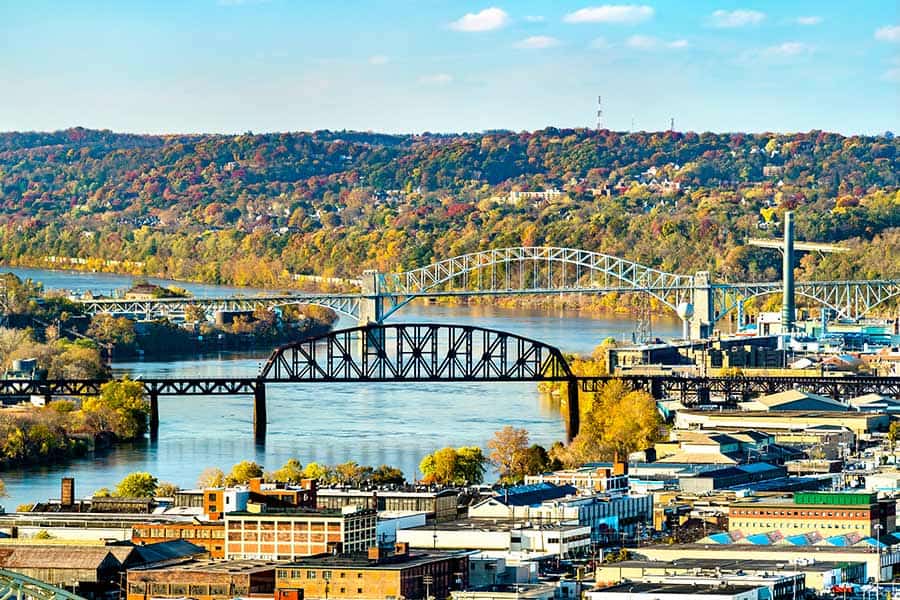
With 446 bridges, it is commonly said that Pittsburgh, Pennsylvania has more bridges than any other city. But why does Pittsburgh have so many bridges?
Pittsburgh’s wealth of bridges comes from its location at the junction of the Monongahela, Allegheny, and Ohio rivers. As early as 1818, Pittsburghians were building bridges. As the city grew, more and more bridges were needed to move people and goods in and out of the city.
So when were most of the bridges in Pittsburgh built? Did they use Pittsburgh steel when they constructed the bridges? Why do people put locks on bridges in Pittsburgh? As you continue on, you will learn the answers to these questions and more.
An Astonishing Number of Bridges
If you look at Pittsburgh on a map, you’ll see that the city sits at the junction of three rivers. The Allegheny River, north of the city, flows from the northeast. The Monongahela River, south of the city, flows from the southeast. The two rivers join in the middle of Pittsburgh and form the Ohio River, which then flows northwest out of Pennsylvania.

The city’s location at the junction of three rivers required bridges to be viable. For a time, the rivers were crossed by ferries that would convey people and livestock from one side to the other. As Pittsburgh began to grow, a more efficient means of crossing the rivers became necessary. In 1818, Pittsburgh’s first bridge – the Monongahela Bridge – was built on the site of what is now the Smithfield Street Bridge, connecting central Pittsburgh with the South Shore.
Of course, one singular bridge was not going to be a sustainable solution. So as Pittsburgh blossomed into a full-scale city, other bridges were erected across the Monongahela, Allegheny, and Ohio rivers. Some prominent examples of early bridges in Pittsburgh include the first Point Bridge, which was built in 1877 and then replaced in 1904 and again in 1959. Similarly, the original Sixth Street Bridge was erected in 1819, then replaced in 1859 and 1892, before being reborn in 1928 as one of the Three Sisters Bridges.
Major bridges such as the Three Sisters or the Birmingham Bridge originated as pedestrian bridges before evolving into road bridges. Before the age of the automobile, bridges were mainly used for foot traffic, people on horses, or even livestock. However, as the horse and buggy evolved into the horseless carriage and eventually the automobile, pedestrian bridges were refurbished or rebuilt into auto bridges.

Road bridges, obviously, help facilitate the movement of cars, trucks, and people across the rivers. But many of Pittsburgh’s bridges came into being to help with another kind of transportation: trains.
Trains were integral to the development of Pittsburgh. In the mid-1800s, the train became an extremely popular mode of transportation for people and goods that needed to travel long distances.
Then, with the advent of Pittsburgh steel and the construction of endless blast furnaces and steel mills along the river, rail bridges began popping up to support the inward flow of raw materials from coal and iron mines and the outflow of finished products like steel wire, metal sheets, and so on.
Many rail bridges were constructed in Pittsburgh to support this endless rail traffic. The Glennwood B&O Railroad Bridge, which crosses the Monongahela, was built in 1884 and refurbished in 1915. Perhaps the most famous rail bridge in Pittsburgh is the Hot Metal Bridge, which shuttled glowing-hot molten iron across the Monongahela to facilitate steelworks.
While it is commonly said that Pittsburgh has more bridges than any other city, an up-to-date inventory of bridges in Pittsburgh shows 297 bridges in the city – although this is a low count owing to an unusually rigorous definition of what constitutes a bridge.

The 297 bridge figure only includes structures more than 20 feet tall that cross a body of water. Many of Pittsburgh’s bridges cross other natural features like ravines, and as time has gone on, many of these land bridges have been taken out of service or filled.
The bridges of Pittsburgh come in a variety of shapes and sizes. There are suspension bridges, truss bridges, arch bridges, beam bridges, and more. There is even a rare lenticular truss bridge in Pittsburgh.
While most of the bridges in Pittsburgh are made of metal, there are also many concrete bridges. Of course, steel brought Pittsburgh to fame, but engineers in the city aren’t afraid to use concrete in their bridges. The Meadow Street Bridge, for example, featured a 208-foot-long concrete arch that was a marvel of engineering at the time of the bridge’s construction in 1910.
While there are, in fact, cities that have more bridges than Pittsburgh, the City of Steel’s collection of bridges is arguably more beautiful and interesting than most. The Three Sisters Bridges are one example of Pittsburgh’s remarkable bridge architecture; the Smithfield Street Bridge is another. Truly, Pittsburgh’s wealth of bridges is something that the city should be proud of.

Keystone Answers Fun Fact: The Roberto Clemente Bridge had more than 11,000 locks on it! The locks were removed recently as part of routine bridge maintenance, but more likely than not, a new crop of locks will soon grace the bridge.
Why are There Locks on Bridges in Pittsburgh?
Placing locks on bridges is an old tradition that can be traced back to the vast wars of Europe in the 1800s. Women seeing their men off to war would bind a lock to a bridge as a symbol of their undying love. This tradition spread and carried on through the years and continues to this day. With so many bridges spanning the local rivers, Pittsburgh is a very popular place for people to place a symbolic lock.

While the symbolism of locking one’s love over an ever-changing river is very romantic, the cumulative weight of thousands of padlocks pulling on non-structural elements can harm the bridges. As such, the City of Pittsburgh has begun removing locks from the city’s many bridges. However, the city recognizes that the locks on the bridge have a lot of sentimental value, so the locks are being made into a beautiful new art project.
When Were Most of the Bridges in Pittsburgh Built?
Pittsburgh has been a city of bridges since the early 19th century. The very first bridge in Pittsburgh was the Monongahela Bridge, which was built in 1818 and spanned the Monongahela River. Construction on bridges has continued throughout the years. Even today, bridges in Pittsburgh are being built and rebuilt, but most of the city’s bridges were constructed during the boom years of the 1880s to the 1930s.
Those years saw the construction of some of Pittsburgh’s most famous bridges, including the Smithfield Bridge, the oldest bridge in the city. Other iconic bridges in the City of Steel that were built in this timeframe include the Three Sisters Bridges and the Philip Murray Bridge.

It’s also important to consider rail bridges. The railroad was the backbone of the boom times of the late 1800s, and as the rail network expanded to include the steel mills of Pittsburgh, many rail bridges were constructed to allow locomotives and freight to cross the rivers. Some have since been converted to road or pedestrian bridges as the steel mills have declined.
Was Pittsburgh Steel Used to Build Pittsburgh’s Bridges?
Most of the bridges in Pittsburgh were made with local steel. Detailed accounts of the metallurgy of the bridges in Pittsburgh could take up a whole volume of books, but the bridges in the area were overwhelmingly built with local materials.
During the time that most of the bridges were being constructed, it would have been impractical to import raw materials like iron or steel, especially with such rich mineral deposits in the area. Why pay thousands of dollars for imported steel when you can get fresh, local steel?
Some of Pittsburgh’s bridges were actually built to transport steel! The Hot Metal Bridge is a good example. Built in 1900, the Hot Metal Bridge was constructed to ferry molten iron to steel fabrication facilities on opposite sides of the Monongahela River. The molten iron, which is about 2,000 degrees Fahrenheit, was pulled across the river in special “torpedo cars.”
Today, the Hot Metal Bridge has been converted into a beautiful pedestrian bridge. While many rail bridges in Pittsburgh remain active, the decline of the steel industry and the changing face of the world have led many rail bridges to be converted to carry cars or foot traffic across Pittsburgh’s rivers.
The Other Side of the Bridge
The Pittsburgh of today is a rising phoenix. During the industrial heyday of the late 1800s and early-to-mid 1900s, Pittsburgh’s steel industry boomed, and the city built tons of beautiful, shining bridges to support commerce and help the city thrive. Despite many recent challenges, Pittsburgh is coming back strong, with a thriving local economy and a bright future ahead. The many beautiful bridges of Pittsburgh will keep this city healthy and vital for decades to come.






